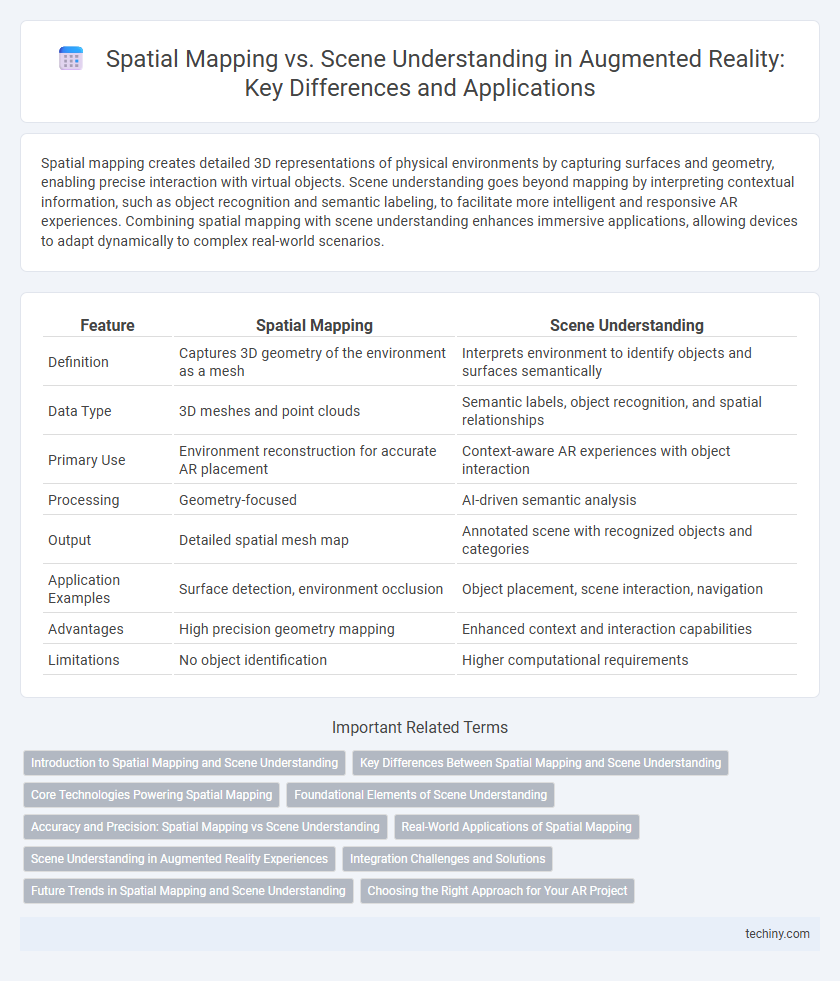Spatial mapping creates detailed 3D representations of physical environments by capturing surfaces and geometry, enabling precise interaction with virtual objects. Scene understanding goes beyond mapping by interpreting contextual information, such as object recognition and semantic labeling, to facilitate more intelligent and responsive AR experiences. Combining spatial mapping with scene understanding enhances immersive applications, allowing devices to adapt dynamically to complex real-world scenarios.
Table of Comparison
| Feature | Spatial Mapping | Scene Understanding |
|---|---|---|
| Definition | Captures 3D geometry of the environment as a mesh | Interprets environment to identify objects and surfaces semantically |
| Data Type | 3D meshes and point clouds | Semantic labels, object recognition, and spatial relationships |
| Primary Use | Environment reconstruction for accurate AR placement | Context-aware AR experiences with object interaction |
| Processing | Geometry-focused | AI-driven semantic analysis |
| Output | Detailed spatial mesh map | Annotated scene with recognized objects and categories |
| Application Examples | Surface detection, environment occlusion | Object placement, scene interaction, navigation |
| Advantages | High precision geometry mapping | Enhanced context and interaction capabilities |
| Limitations | No object identification | Higher computational requirements |
Introduction to Spatial Mapping and Scene Understanding
Spatial mapping creates a detailed 3D model of the physical environment by capturing surfaces and geometries using sensors and cameras. Scene understanding interprets this spatial data to recognize objects, their relationships, and contextual information within the mapped environment. These technologies enable augmented reality applications to interact seamlessly with real-world surroundings by combining accurate environmental models with semantic comprehension.
Key Differences Between Spatial Mapping and Scene Understanding
Spatial mapping creates detailed 3D models of physical environments by capturing surface geometry and spatial dimensions, enabling accurate placement of virtual objects. Scene understanding goes beyond geometry by interpreting semantic information such as object recognition, material properties, and environmental context to enable more intelligent interactions in augmented reality. The key difference lies in spatial mapping's focus on geometric accuracy versus scene understanding's emphasis on contextual awareness and semantic interpretation.
Core Technologies Powering Spatial Mapping
Spatial mapping relies on LiDAR sensors, depth-sensing cameras, and simultaneous localization and mapping (SLAM) algorithms to create accurate 3D models of physical environments. Core technologies include point cloud generation, mesh reconstruction, and real-time environmental scanning, enabling devices to capture geometry, texture, and surface data for precise digital overlays. These foundational components power spatial mapping by continuously updating spatial information to support immersive augmented reality experiences.
Foundational Elements of Scene Understanding
Spatial mapping generates a detailed 3D mesh of the physical environment, capturing geometry and surface data crucial for augmented reality applications. Scene understanding builds on this data by interpreting spatial information to identify objects, boundaries, and semantic context, enabling intelligent interaction with the environment. Foundational elements of scene understanding include spatial mapping, object recognition, semantic segmentation, and environmental semantics, which together enhance AR experiences with context-aware content placement and interaction.
Accuracy and Precision: Spatial Mapping vs Scene Understanding
Spatial mapping in augmented reality captures the geometric structure of the environment with high precision, enabling accurate placement of virtual objects relative to physical surfaces. Scene understanding enhances spatial mapping by analyzing semantic information like object recognition and environment context, improving the accuracy of interactions and user experience. While spatial mapping excels in detailed surface reconstruction, scene understanding provides deeper environmental insight, balancing precision with contextual awareness.
Real-World Applications of Spatial Mapping
Spatial mapping enables precise 3D reconstruction of physical environments, facilitating real-time interaction in augmented reality applications such as interior design, navigation, and industrial maintenance. Scene understanding builds on this by interpreting the spatial data to identify objects and their relationships, enhancing context-aware AR experiences. Real-world applications leverage spatial mapping to create immersive environments where virtual content seamlessly integrates with the physical world, driving efficiency and user engagement.
Scene Understanding in Augmented Reality Experiences
Scene understanding in augmented reality leverages advanced algorithms to interpret the environment beyond simple spatial mapping, identifying objects, surfaces, and contextual elements to enable more immersive and interactive experiences. It enhances AR applications by providing semantic information, allowing virtual elements to interact naturally with real-world scenes, improving user engagement and accuracy. Technologies such as deep learning and computer vision play a critical role in enabling dynamic scene recognition and adaptive AR content placement.
Integration Challenges and Solutions
Spatial mapping captures detailed geometric data of an environment, creating precise 3D meshes, while scene understanding interprets semantic context such as object identification and spatial relationships. Integration challenges include data alignment inaccuracies, computational overhead, and latency impacting real-time interaction performance in AR systems. Solutions involve optimizing sensor fusion algorithms for synchronized data streams, employing machine learning models for efficient semantic labeling, and leveraging edge computing to reduce processing delays.
Future Trends in Spatial Mapping and Scene Understanding
Future trends in spatial mapping emphasize higher resolution 3D environmental reconstructions combined with real-time data processing powered by AI and edge computing. Scene understanding is evolving through advanced machine learning algorithms capable of semantic segmentation, object recognition, and contextual awareness to enable more immersive and interactive augmented reality experiences. Integration of multimodal sensors and cloud-based computing will further enhance the accuracy and scalability of spatial mapping and scene interpretation in AR applications.
Choosing the Right Approach for Your AR Project
Spatial mapping captures detailed 3D representations of physical environments, ideal for precise object placement and immersive interaction in augmented reality applications. Scene understanding interprets and categorizes the environment's elements, enabling context-aware experiences like object recognition and dynamic content adaptation. Selecting the right approach depends on your AR project's requirements for accuracy, real-time processing, and user interaction complexity.
Spatial Mapping vs Scene Understanding Infographic

 techiny.com
techiny.com